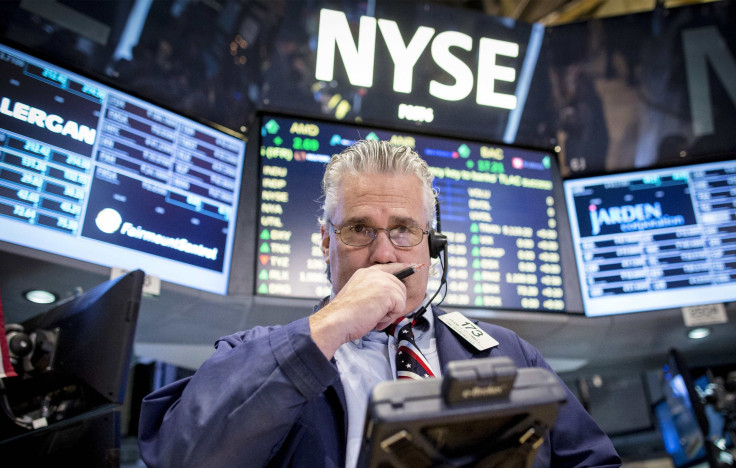Dow Jones Industrial Average Tumbles 100 Points As Plunging Oil Prices Overshadow Data

U.S. stocks dropped Monday, with the blue-chip Dow Jones Industrial Average falling as much as 165 points after U.S. oil prices tumbled below $56 for the first time since May 2009. Although Brent crude, the benchmark for global oil prices, rallied in early trading, oil extended losses after OPEC maintained its decision not to slash output, despite global fears of cooling demand.
The Dow, which measures the share prices of 30 large industrial companies, dropped 99.99 points, or 0.58 percent, to finish at 17,180.84; the S&P 500 stock index, which tracks the share prices of the nation's 500 largest publicly traded companies, fell 12.70 points, or 0.63 percent, to end at 1,989.63. The tech-heavy Nasdaq Composite lost 48.44 points, or 1.04 percent, to finish at 4,605.16.
Benchmark indices initially opened higher Monday, with the Dow rallying more than 100 points following the opening bell, after data showed U.S. manufacturing output jumped in November. However, equities struggled to hold on to early gains in afternoon trading as the decline in global crude oil prices continue to weigh on investor sentiment. “Equities appear to be a holiday sales driven market held hostage by oil,” said Terry Sandven, chief equity strategist at U.S. Bank Wealth Management.
U.S. oil benchmark West Texas Intermediate crude (WTI) fell more than 3 percent on Monday to $55.91 per barrel, for Jan. 15 delivery, on the New York Mercantile Exchange (NYMEX). Meanwhile, global benchmark Brent crude fell 2.26 percent Monday to $60.45 a barrel on the London ICE Futures Exchange.
The Dow dropped more than 300 points Friday after U.S. crude oil prices fell below $58 a barrel for the first time since May 2009. Weighing on equities last week and Monday was the continued slide in energy prices, as low oil prices have offsetting implications to both economic growth and equity prices, Sandven said.
On the positive side, consumers are benefiting from low energy prices. The average price of gasoline in the U.S. was $2.68 last week, according to the Energy Information Administration, which is 59 cents below year-ago levels. “That’s a big drop. Low energy costs are bolstering sentiment and discretionary income, which bode well for overall sales during this holiday season,” Sandven said. But conversely, companies operating within and around the oil patch are perhaps less sanguine about low energy prices. As prices decline, so do reductions expected in energy exploration, production and distribution services. “All of that tends to weigh on earnings growth for energy-related companies, which contributed to fair amount of last week’s sell-off,” Sandven said.
Data Monday showed U.S. manufacturing output soared last month after industrial production jumped 1.3 percent in November, the largest gain since May 2010, the Federal Reserve said. Factory output climbed 1.1 percent in November while October's data was revised higher to a 0.4 percent gain from a previously reported 0.2 percent increase. The gains boost U.S. manufacturing output to 4.8 percent over the past 12 months, eclipsing a prerecession high set in December 2007, which signals a sign of the U.S. economy's economic strength.
But separate data revealed manufacturing activity in New York contracted for the first time in almost two years. The New York Empire State Index, based on a monthly survey of manufacturers, dropped 14 points to 3.6, its first negative reading in nearly two years, according to the Federal Reserve Bank of New York.
“I think it’s likely that last week's adjustment to equity prices had not only to do with crashing prices for Crude, but also a little something to do with anticipation of a change in Fed language, as well as forward-looking economic projections,” Stephen Guilfoyle, chief economist at Sarge986.com, said in a note Monday. “The big enchilada this week will be the results of and press conference following the FOMC [Federal Open Market Committee] meeting.”
Economists are looking ahead to the Federal Reserve’s final two-day policy meeting of the year, Tuesday and Wednesday, to discuss the possible timing of when the central bank will increase interest rates, which most economists anticipate will happen in the middle of 2015.
“We still anticipate that several more blockbuster employment reports will persuade the Fed to begin hiking interest rates as early as next March,” Capital Economics said in a report Monday. The London-based research consultancy firm expects the Fed to raise rates close to 1.25 percent by the end of 2015 and to close to 3 percent by the end of 2016.
Tuesday, the U.S. Commerce Department is scheduled to release its data on new residential construction projects last month that includes housing starts, which is considered to be a critical indicator of economic strength within the U.S. economy. Global financial information company Markit will publish its preliminary “flash” Purchasing Managers Index (PMI) for the U.S., Germany, France and the Eurozone, which is used as an indicator of the economic health of the global manufacturing sector. Also Tuesday, the HSBC is slated to issue its preliminary Purchasing Managers Index for China, an early indicator of economic health in the Chinese manufacturing sector.
© Copyright IBTimes 2024. All rights reserved.












